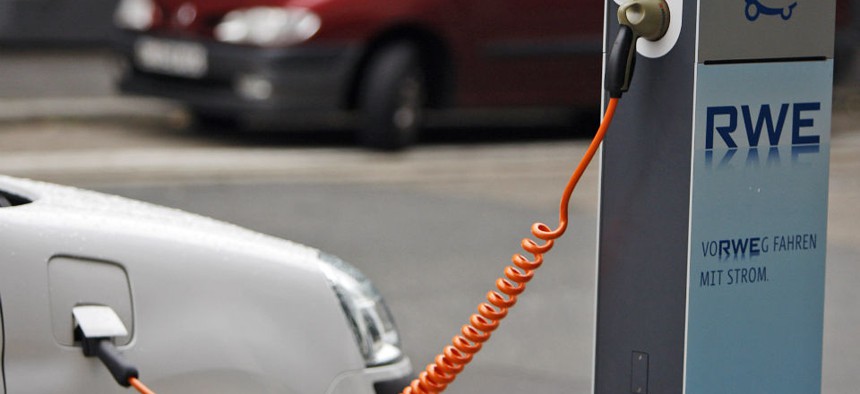Two Big Labs Step Back From the Most Promising Next-Generation Battery

A charging point for electric cars. Frank Augstein/AP File Photo
IBM and the US-funded Joint Center for Energy Storage Research (JCESR) have ratcheted down or outright abandoned their work on the lithium-air battery.
In a sign of more gloom in the struggle for a better battery, two major US labs have quietly downgraded research on a technology until now widely believed to be the most promising path to a competitive electric car.
IBM and the US-funded Joint Center for Energy Storage Research (JCESR) have ratcheted down or outright abandoned their work on the lithium-air battery, a concept in which oxygen would react with lithium to create electricity.
Over the last few years, lithium-air has generated much enthusiasm because of the prospect that a competitively priced electric car using such a battery could travel 500 miles on a single charge, and thus finally put battery-driven vehicles on equivalent ground with conventional models.
Most current electrics, using lithium-ion batteries, travel no more than 100 miles on a charge; those that go further, like the Tesla S, are expensive. Lithium-ion technology uses a cathode generally built of metal oxides including cobalt, which is costly, and also results in limited range.
Lithium-air, conversely, uses cheap carbon as a cathode–the pivotal flow of oxygen through the cathode gives the battery its name–and takes you further. But it has remained theoretical because of its challenges. Among them: the other electrode in such batteries—the anode—is pure lithium metal, which provides a lot of energy but also ignites when exposed to water, carbon dioxide, or other contaminants. What is more, the lithium-oxygen itself can turn into unwanted lithium carbonate. Hence, the battery would need screening technology to keep both electrodes pristine, adding weight and cost and obviating the advantages of going to all that trouble.
Yet in 2009, IBM announced plans to tackle lithium-air, which it called the Battery 500 Project. Using its Blue Gene supercomputer and collaborations with partners including federally funded national labs and commercial players, IBM set out to make lithium-air a reality. The move put the company instantly on a bold, leading course in what—if successful—promised to be a highly lucrative, gigantic industry. While IBM proceeded, the US Energy Department three years later awarded $120 million to establish JCESR at Argonne National Laboratory, outside Chicago. The objective was to put the US in the leading position for next-generation batteries after lithium-ion. Among JCESR’s initial projects: lithium-air.
But recently, the labs had a new think
In a little-remarked-upon article in March, Nature magazine reported that IBM’s Winfried Wilcke, director of the Battery 500 Project, had a “change of heart” about lithium-air and had turned his favor to a technology featuring sodium. In an electric car, a sodium-air battery, he said, stood a better chance of meeting the economics needed to compete with conventional cars. It was a dramatic move, with the most bullish player in lithium-air—Wilcke himself—calling it a day.
Wilcke did not respond to emails. An IBM spokesman told Quartz that the Nature report is accurate but said that the company is now working on both lithium-air and sodium.
About the same time, JCESR dropped its lithium-air project entirely. Like IBM, JCESR did not announce the decision publicly. Kevin Gallagher, a JCESR manager, said it concluded that the challenges were too overwhelming to resolve any time soon. “The penalty of using gaseous reactions overwhelmed any advantage,” he told Quartz.
Some are still in the game
Lithium-air is not being abandoned everywhere. At Argonne, Michael Thackeray is directing work on a novel hybrid battery combining lithium-ion and lithium-air. The result is the potential for a battery with specific density of 500 watt hours per kilogram, two-and-a-half times greater than today’s best commercial lithium-ion cell.
Peter Bruce, a leading lithium-air researcher at the University of St. Andrews, said battery scientists should work both on technologies with a high certainty of success—such as better lithium-ion—and riskier ideas like lithium-air. “So far we haven’t seen any show stoppers for lithium-air, but equally I don’t know whether it will work and be viable,” he said. “I don’t believe anyone does at this stage.”
Bruce is right. But battery scientists seem much less prepared to spend time finding out.
Reprinted with permission from Quartz. The original story can be found here.
NEXT STORY: You Can Now Get a 3D Printer for Under $200






